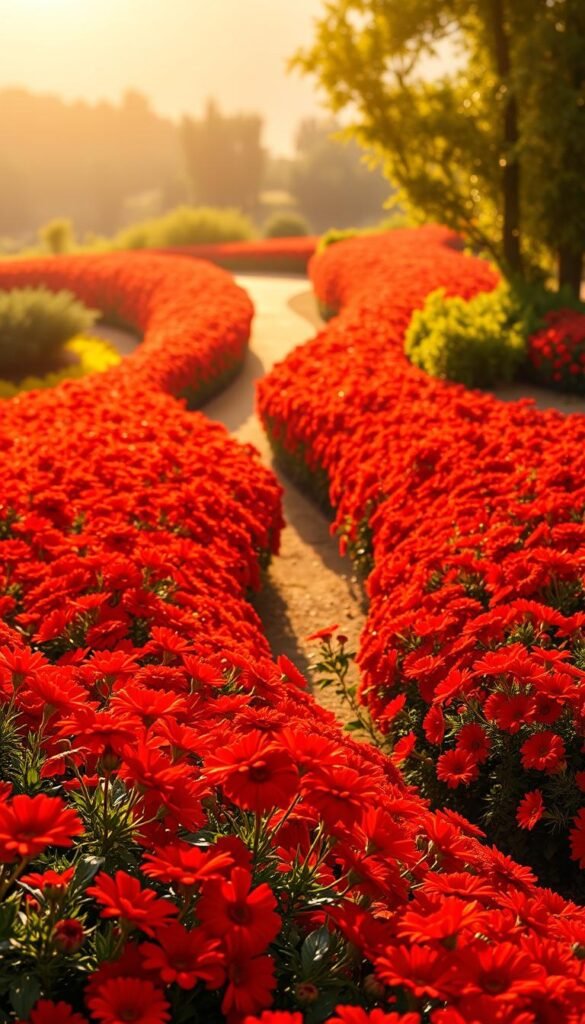Imagine stepping into an outdoor space where vibrant hues command attention. Red blossoms have an unmatched ability to energize landscapes, turning ordinary plots into eye-catching focal points. This fiery shade naturally contrasts with lush greenery, creating visual drama that feels both intentional and effortless.
Designers often treat these blooms like exclamation marks in a sentence. A single cluster of crimson roses or a row of scarlet tulips can guide the eye across your yard. Recent plant breeding breakthroughs offer varieties with richer tones and longer-lasting petals, perfect for modern gardeners seeking drama without overwhelm.
Sunlight plays a key role in maximizing color impact. Position your brightest specimens where golden rays enhance their depth and warmth. Whether you’re working with patio containers or sprawling beds, strategic placement ensures every petal contributes to your garden’s story.
New cultivars arriving in 2025 showcase berry-inspired reds and velvety textures. These innovations let you experiment with shades from crimson to burgundy while maintaining harmony. Remember: restraint often amplifies effect. A few well-chosen plants can transform your space into a living masterpiece of color theory.
Understanding the Vibrancy of Red in Your Garden
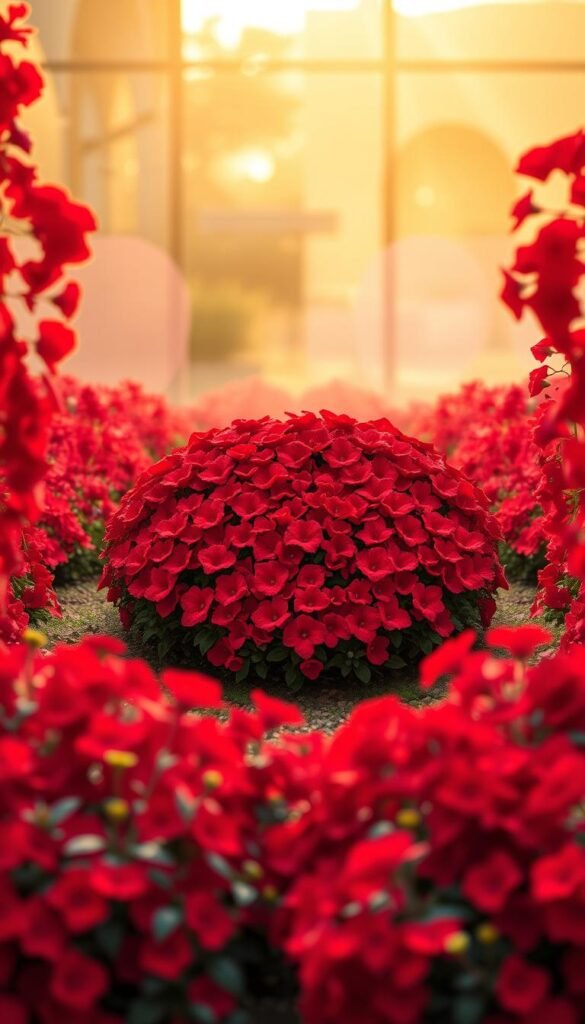
Red blooms ignite landscapes like living flames, demanding attention through pure chromatic intensity. This primary color shines brightest when unmodified—think fire-engine hues in Crocosmia ‘Lucifer’ or Monarda’s scarlet spikes. But true magic happens when you explore its variations through tint and tone.
Exploring True Reds, Warm Red-Orange, and Deep Maroon Hues
Pure red flowers like cypress vine deliver maximum visual punch. For sun-drenched areas, warm red-orange varieties like lantana or corn poppies radiate energy. Cooler maroon shades—think chocolate cosmos or ‘Black Prince’ snapdragons—add depth to shaded corners.
| Red Type | Characteristics | Plant Examples |
|---|---|---|
| True Red | No added pigments | Cypress vine, Crocosmia |
| Red-Orange | Yellow undertones | Lantana, Trumpet vine |
| Cool Red | Blue undertones | Chocolate cosmos, Clematis |
Using the Color Wheel and Red’s Complementary Contrast
Red’s natural partner? Green foliage. This complementary pairing makes both colors appear richer. When planning your best red flowers, consider nearby yellows for warm blends or purples for dramatic contrasts. Darker shades ground brighter hues, creating balanced compositions.
Sunlight intensifies red pigments. Position crimson blooms where afternoon rays backlight their petals. For cooler maroons, morning light reveals velvety textures. Your color palette becomes a living painting when you master these interactions.
Planning Your Bold Red Flower Garden
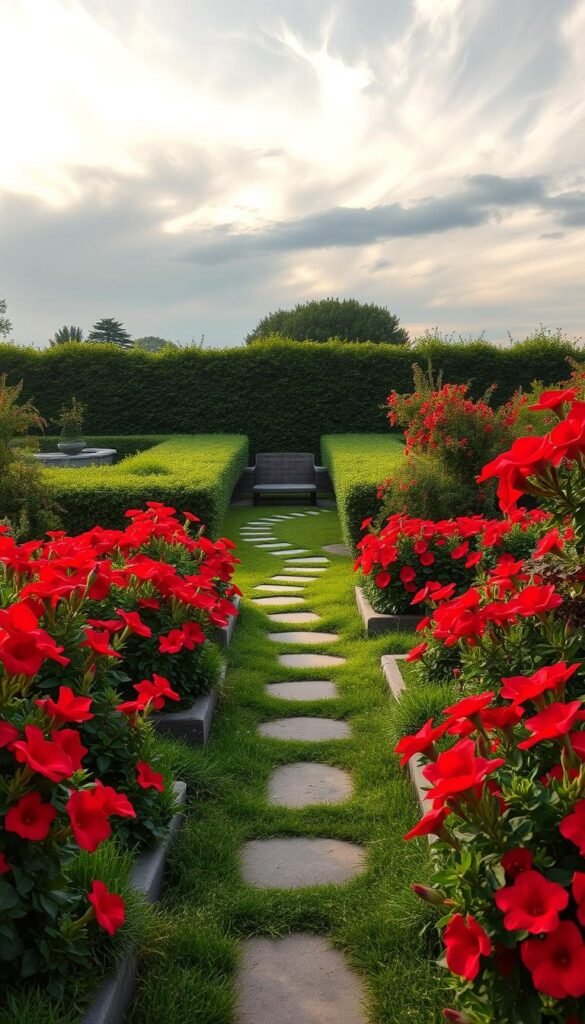
Crafting a vibrant outdoor space begins with smart organization. Start by listing plants based on their sunlight needs, mature size, and bloom cycles. This approach prevents overcrowding and ensures your fiery hues shine all season.
Designing Layouts and Choosing Complementary Elements
Professional growers swear by color mapping. Sketch your space using graph paper or digital tools for elevating your garden’s. Group plants with similar water needs, and remember: taller varieties belong at the back of borders.
| Factor | Purpose | Examples |
|---|---|---|
| Color Harmony | Balances intensity | White yarrow, yellow coreopsis |
| Growth Habit | Prevents overcrowding | Dwarf dahlias, vertical salvias |
| Light Needs | Ensures proper blooming | Sun-loving geraniums, shade-tolerant begonias |
| Maintenance | Simplifies care | Drought-tolerant sedum, self-cleaning petunias |
Containers offer clever solutions for small yards. Try pairing scarlet geraniums with silver artemisia in pots near seating areas. For large spaces, create rhythm by repeating red clusters along pathways.
“Always place your boldest reds where they’ll catch afternoon light – it makes them glow like stained glass.”
Cool down intense areas with pale companions. Moonflowers climbing a trellis or snow-in-summer groundcover soften crimson bursts. This balance keeps your design energizing without feeling chaotic.
Creating a Red Flower Garden: Bold Statement Beds with Fiery Accents
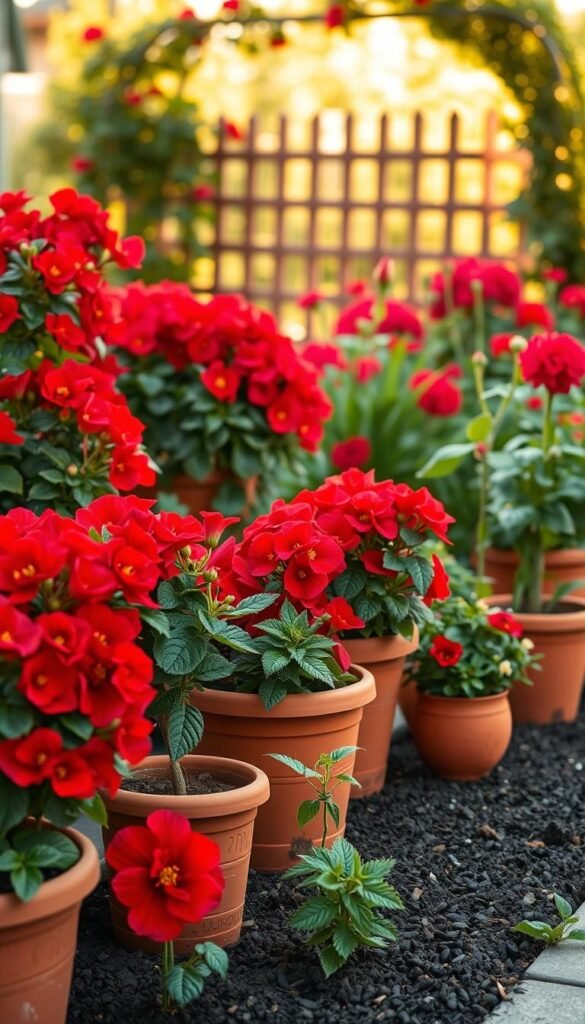
Sun-drenched spaces become radiant stages when you choose blooms that thrive under bright skies. The right selections ensure your fiery palette stays vivid from dawn till dusk, even in intense summer heat.
Selecting the Best Red Flowers and Foliage for Full Sun
These champions laugh at harsh rays while delivering nonstop color:
- Hibiscus – Dinner-plate blooms last all summer
- Canna – Tropical leaves frame torch-like flowers
- Salvia – Spiky forms attract hummingbirds
Pair them with maroon-leaved companions like New Zealand flax. Their deep tones prevent brighter reds from overwhelming the eye.
Incorporating Fiery Accents with Containers and Borders
Elevate patios with pots overflowing with scarlet lantana or petunias. For vertical drama, train mandevilla vines up obelisks – their trumpet-shaped blooms glow against fences. The Hidcote Manor approach works wonders: alternate crimson flowers with burgundy foliage plants in repeating patterns.
Dark-leaved cannas make perfect bookends for colorful container gardening displays. Try grouping three matching pots near entryways for instant curb appeal. Remember: repetition creates rhythm, while contrasting textures keep designs exciting.
Tips and Tricks for Maximizing Garden Impact
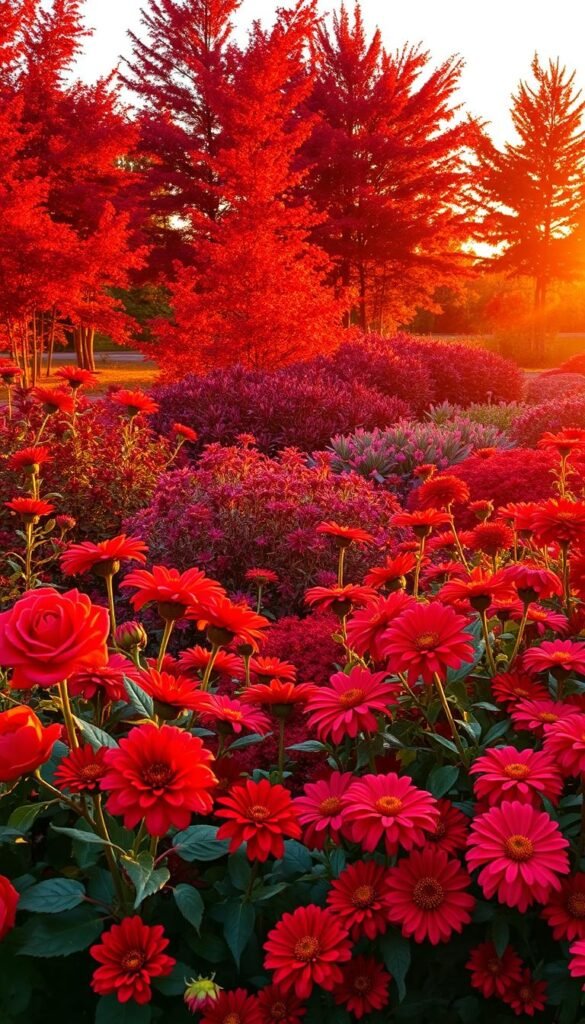
Transform your outdoor canvas with smart color strategies that amplify visual energy. Whether working with compact patios or sweeping lawns, these professional techniques ensure your fiery palette commands attention without overwhelming.
Expert Advice on Pairing Red with Analogous Colors
Red-orange flowers sing when paired with their neighbors on the color wheel. Try these combinations:
- Marigold yellow for sunrise warmth
- Lime heuchera leaves as zesty accents
- Coral bells to bridge red and pink tones
For bold drama, introduce blue salvias or delphiniums. Their cool tones make adjacent scarlet blooms appear to vibrate with intensity.
Styling Techniques Using Dark Foliage and Complementary Shades
Deep purple smokebush or burgundy coleus leaves act like velvet frames for crimson petals. These foliage choices absorb light rather than compete with it. “Dark greens and purples turn reds into living jewels,” notes award-winning designer Lila Martinez.
Pro Tips for Balancing Bold Colors in Any Space
In petite gardens, cluster ruby-toned celosia in containers with silver artemisia. For expansive beds, alternate red dahlias with white phlox every 8 feet. Time your plantings for continuous impact:
| Season | Red Flowers | Companions |
|---|---|---|
| Spring | Tulips | Yellow pansies |
| Summer | Zinnias | Blue sage |
| Fall | Mums | Purple kale |
Round blooms like peonies create color masses, while vertical snapdragons guide the eye upward. This mix of forms keeps designs dynamic from early summer through frost.
Bringing Your Garden Vision to Life
A garden bursting with fiery hues begins with the right plant partners. Curated plant lists simplify choices, whether you’re eyeing New Zealand flax for structure or zinnias for summer-long sparks. Mix annuals like geraniums with perennials such as crocosmia to balance instant color and lasting impact.
Don’t forget nature’s decorators – berry-producing shrubs. Winterberry and holly add scarlet pops long after flowers fade, feeding birds while enhancing your design. Pair these with maroon-leaved cannas or coleus to maintain visual heat through fall.
Soil preparation ensures your red stars thrive. Test drainage where you’ll plant moisture-loving astilbes or drought-tolerant sedum. For container displays, use potting mix with slow-release fertilizer to keep blooms vibrant from spring through frost.
Phase your planting over seasons for continuous drama. Start with tulips and pansies in early months, transition to daylilies and salvias in summer, then let mums and ornamental kale take the autumn stage. This approach builds your garden’s story while letting each plant shine.

